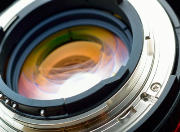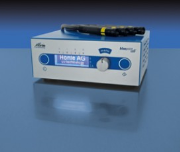 For the uninitiated, the selection and use of adhesives in the design and or the manufacturing of a product can be a daunting prospect. How on earth are you supposed to know which one is the most suitable for your application. Here we explain all you need to know about UV adhesives.
For the uninitiated, the selection and use of adhesives in the design and or the manufacturing of a product can be a daunting prospect. How on earth are you supposed to know which one is the most suitable for your application. Here we explain all you need to know about UV adhesives.
Ultra violet light curing (UV) adhesives are just one example of how a simple adhesive chemistry can be seen as mysterious, complicated to use and very high tech, which often puts users off. That negative image belies the many valuable features and benefits of UV and visible light curing adhesive systems – and how easy they are to use.
UV light curing adhesives are ‘’cure on demand’’ adhesives and remain completely inert and in a liquid state when applied to a substrate until they are subjected to controlled and concentrated UV light. These adhesives are used in many different applications, including the manufacture of disposable medical devices, such as chest drains, syringe needle bonding, catheter tube/bag sets and blood filter housings, electronics, optical lens bonding and fibre optic filament splicing. They are also widely used in glass and acrylic furniture manufacture, as well as decorative glass, display cases, signage and trophies to name just a few! They are extremely versatile products, ideally suited to high volume production outputs as well as the artisan craftsmen.
Typically there are two types of chemistry to choose from either epoxy or acrylate based adhesives depending on your application. Acrylate based adhesives are widely used for bonding clear substrates such as PMMA, PVC, SAN, PC and glass either to themselves, in combination or indeed to some metals.
 The benefits of acrylate based adhesives are numerous:
The benefits of acrylate based adhesives are numerous:
- Can be used in a wide variety of applications.
- Fast curing, making them very useful for high output production.
- Excellent adhesion properties.
- Wide range of viscosities from ultra-low to thick gel.
Epoxy-based UV adhesives tend to be used as coatings – for example as a ‘glob top’ protective coating to protect chips on PCB’s, conformal coatings on PCB’s, dome coating on badges, protecting wire contacts on PCB’s or as an adhesive for SMD attachment.
The benefits of epoxy based UV adhesives are:
- Have superior environmental resistance.
- Wider operating temperature range.
- Low ionic and alkali content.
- Low shrinkage giving better positioning and minimal movement.
- Cure to a tack-free dry finish.
 Getting It Right
Getting It Right
Selecting the correct UV light curing equipment for your specific application is also critical to the success of your production. In the main, there are two types of UV light curing systems – high pressure gas discharge lamps or LED lamps. Acrylic and epoxy based adhesives can be cured with either system. Some special acrylic adhesives can be cured using high intensity visible light 405-420nm for example when bonding UV impermeable PC or laminated glass. Others, particularly in electronic PCB applications may require a combination of UV light and heat to cure the areas in shadow underneath SMD’s. But the vast majority can be cured using high intensity 365nm UV light.
Unlike gas discharge lamps which have a broad light spectrum ranging from 340nm to 420nm, LED light sources have a monochromatic lightspectrum with specific light wavelengths matched to the curing requirements of the adhesive used, with the most common being 365nm and 405nm. LED curing lamps have no warm up or cool down period, they can be switched on and off repeatedly providing instant full intensity UV light. An additional benefit is that LED light sources do not produce any infrared head which could distort or damage temperature sensitive substrates such as thin films or components on a PCB.
By contrast gas discharge lamps have to warm up for a few minutes before they reach optimum intensity and are ready to use. Similarly they cannot be turned on and off repeatedly as a thermal cut off switch prevents this. The lamp has to cool down which could take up to 10 minutes before it is ready to use again. This can have an impact on the speed of production. The useful bulb life of a gas discharge lamp is around 500-750 operating hours whereas an LED lamp can last between 10,000 and 20,000 operating hours depending on the system used.
 Careful consideration should be given to the most suitable type of UV light system required for your given project or specific application. There are five main types of UV light system.
Careful consideration should be given to the most suitable type of UV light system required for your given project or specific application. There are five main types of UV light system.
- Handheld or jig mounted ‘flood lamps’, which emit UV over a given area and can be combined with a conveyor system to deliver the product to the light source.
- Fibre optic light guides. These deliver UV light along single or multiple fibre optic or liquid filled light guides which give a very narrow beam of intense UV light.
- UV Light cabinets such as Honle’s UVA cube are self-contained enclosures in which multiple bonded parts can be placed and cured at the same time. They can also be used as sun simulation chambers.
- UV Laser pens are simple hand held precision LED UV light sources and are ideal for production or laboratory work. They offer great flexibility in delivering UV light with minimal heat output.
- LED UV Torch. This is a simple, low cost high power UV torch that emits a high intensity narrow beam of 365nm UV light. It is ideal for small bond lines, prototyping, small scale production, creating decorative artwork. Ideal for site work too as it is battery powered.
 For more information click on the link to view some UV bonding videos.
For more information click on the link to view some UV bonding videos.
https://eurobond-adhesives.co.uk/videos/
Or contact the Eurobond Adhesives technical team.
Tel +44 (0) 1795 427888.

